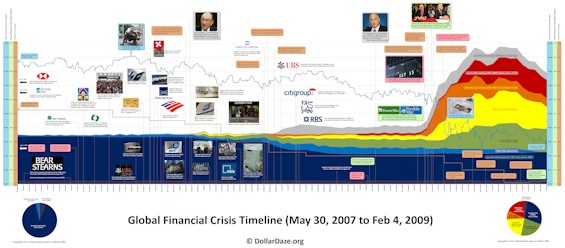The U.S. Dollar and Monetary Policy
Currencies / US Dollar Feb 13, 2009 - 11:31 AM GMTBy: Mike_Hewitt

 One of the chief mandates of the U.S. Federal Reserve is to manage the nation's monetary stock. This essay analyzes the historic growth of the American monetary stock (or aggregates) since 1960 and looks at some recent developments revealing a marked adjustment in policy. These changes are a direct response to the on-going worldwide financial crisis that escalated in September 2008 following the collapse of Lehman Brothers.
One of the chief mandates of the U.S. Federal Reserve is to manage the nation's monetary stock. This essay analyzes the historic growth of the American monetary stock (or aggregates) since 1960 and looks at some recent developments revealing a marked adjustment in policy. These changes are a direct response to the on-going worldwide financial crisis that escalated in September 2008 following the collapse of Lehman Brothers.
U.S. Monetary Aggregates
The U.S. Federal Reserve regularly publishes Money Stock Measures showing a breakdown for the different components of each measure. Data from this source was used to produce the following chart. 1
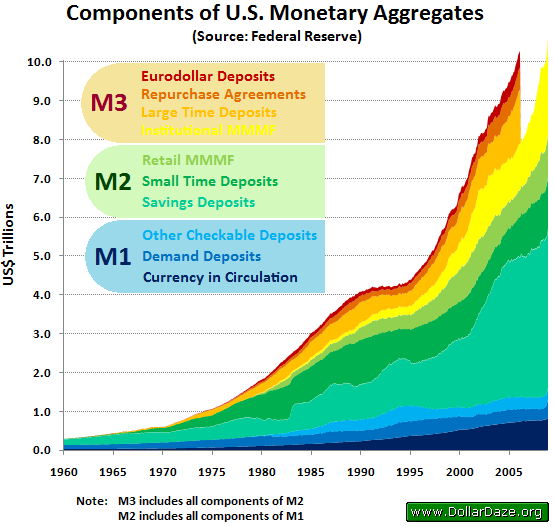
M1 includes the most liquid forms of money. Higher order monetary measures include money acting more as a 'store of value' as opposed to a 'means of exchange'.
The U.S. Federal Reserve stated that it would cease publishing the M3 monetary aggregate as of May 23, 2006 and all of its components except for that of Institutional Money Market Mutual Funds (MMMF) citing that " ...the costs of collecting the underlying data and publishing M3 outweigh the benefits. "
The reason for continuing MMMF is that it is a component of the recently devised Money-Zero-Maturity (MZM) monetary aggregate. This measure includes M2 less Time Deposits plus all MMMF and is deemed by many as best representing the money available within an economy for spending and consumption. Some economists oppose the inclusion of money market mutual funds as 'money' because, while liquid and eligible to be sold without incurring a capital loss, they are still technically an asset that first must be sold in order to be spent.
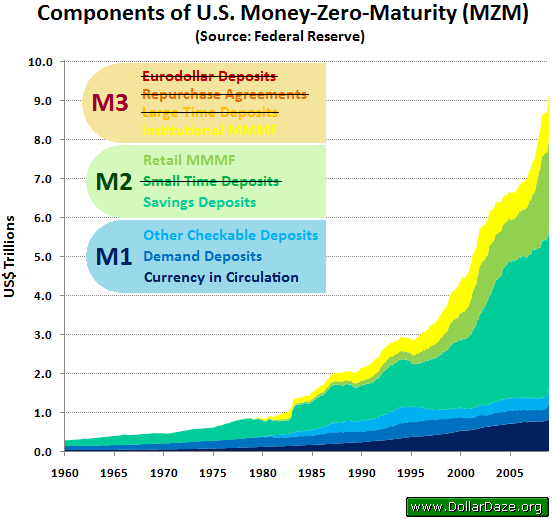
Controlling the Money Supply
The Federal Reserve primarily controls the U.S. monetary stock through three mechanisms:
1. Setting the Federal Funds Rate
By decreasing interest rates and effectively making money less expensive to borrow, the Federal Reserve increases the demand for money. Conversely, the Federal Reserve can lower the demand for money by targeting a higher interest rate, as Paul Volcker did early in his tenure as Federal Reserve Chairman from August 6, 1979 to August 11, 1987. At present, the effective federal fund rate is being targeted to remain between 0 - 0.25%, the lowest in its history in response to the current financial crisis.
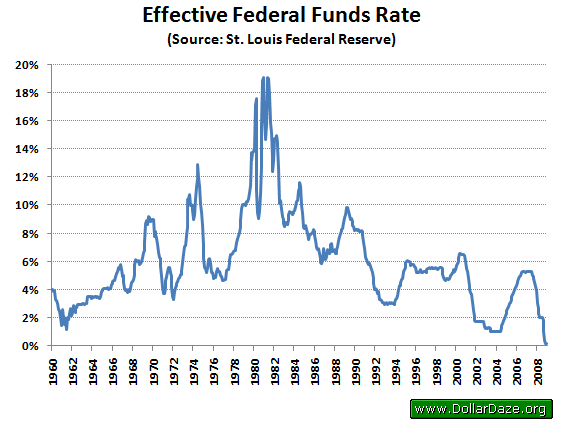
2. Buying U.S. Government Treasuries
When the Federal Reserve purchases U.S. treasuries it loans money to the U.S. government. In addition to the money created by the Fed to purchase these treasuries, the assets of the Federal Reserve increase allowing them to lend more to their clients under the fractional reserve banking system. Previously, the weekly release of the U.S. Federal Reserve balance sheet, known as the Factors Affecting Reserve Balances of Depository Institutions and Condition Statement of Federal Reserve Banks , was a complete non-event, showing a slow and steady increase over the previous week's release. This has since changed following the Fed's historical response to the global financial crisis. A wide variety of assets now back the U.S. Dollar in addition to U.S. Treasuries. Many of these assets, such as Term Auction credit, loans to American Insurance Group, and commercial paper holdings, Mortgage Backed Securities (MBS) are of questionable value due to their illiquidity when previously within the public domain.
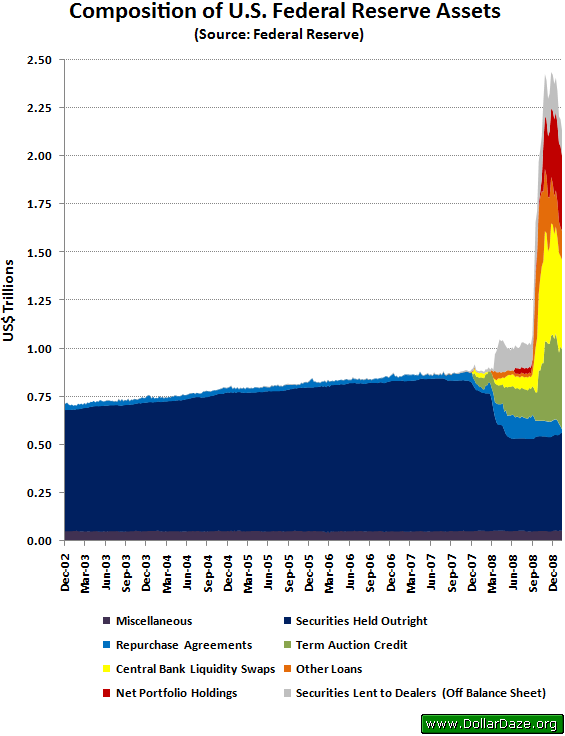
3. Adjusting the Reserve Ratios
All commercial banks operate under a fractional reserve banking system whereby they must legally hold a set amount of cash reserves against the amount they lend out to their customers. By adjusting the reserve ratio limits, the Federal Reserve can affect the amount of money commercial banks are able to lend. Increasing these ratios deflates the money supply because banks can no longer lend out as much as before. Decreasing them has the opposite effect. As of January 1, 2009 the reserve ratios are as follows:
U.S. Reserve Requirements
| $0 to $10.3 million | 0% |
| $10.3 million to $44.4 million | 3% |
| More than $44.4 million | 10% |
Source: The Federal Reserve Board
Inflation and Deflation
Historically, the term inflation referred to an increase in the monetary stock. Deflation described the opposite process. Modern-day usage of these two words now refers only to changes in prices, which may lead to awkward, and potentially misleading, statements. While prices do respond to changes in the monetary stock, it is not a direct relationship, as there are other factors to consider. A ten percent increase in the monetary stock does not directly correspond to a ten percent price increase for all goods.
Reasons for this discrepancy include the following:
- Unavoidable time delays required for market participants to assess the impact of newly created money entering the public domain. Components of the economy that are the first to receive newly created money benefit the most as they can spend it at full purchasing power. Those components which receive little or none of it experience only higher prices.
- The supply and demand dynamics for goods are independent from the supply and demand of money. For instance, advances within the telecommunications industry during the 1990's, outpaced the growth of monetary stock during this period resulting in lower prices for related equipment and services.
- Speculation may lead to unfounded price levels well above what fundamentals would suggest. The most recent example of this is the 70% price collapse in crude oil from over $140 in July 2008 to around $40 today occurring during a time when the U.S. total monetary stock increased by 21.5% from $8.7 trillion to $10.6 trillion.
While changes to the monetary stock do not account for 100% of the changes in prices, they are especially important over longer time periods, often becoming the dominant factor.
The U.S. Monetary Base
Recent announcements over the escalating U.S. monetary base have surfaced in the financial media. The U.S. monetary base consists of several components. The currency in circulation was historically the predominant component. Recently, Federal Reserve Bank balances have become sizeable components as well. So long as the reserve cash remains in bank vaults or on deposit with the Federal Reserve, it is not money.
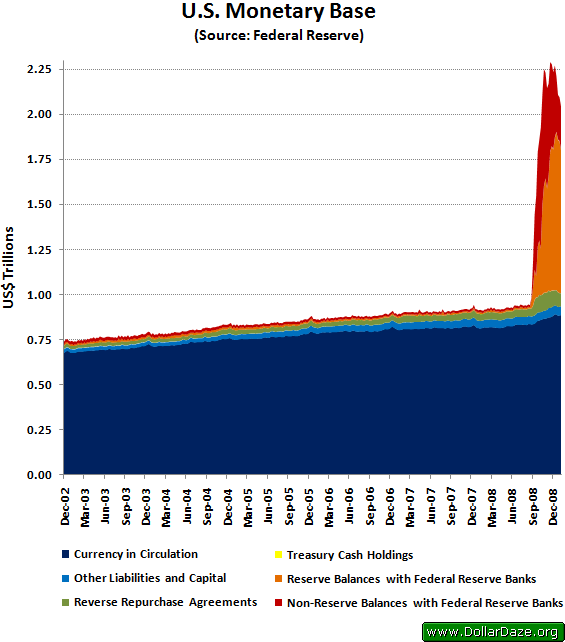
The sharp increase in bank reserves is a result of the current efforts to recapitalize the U.S. banking industry. The above graph visually shows the historic significance of these actions. While bank reserve cash does not directly enter the financial system as money , it can enter through the fractional reserve banking system as debt .
The Fractional Reserve Banking System
Fractional reserve banking is the practice whereby the value of issued bank loans far exceeds the amount of cash held in reserve. 2
Assuming a ratio of ten percent, a commercial bank can lend out $10 million for every $1 million it holds in reserve. This makes for particularly profitable business, as annual revenue on $10 million in mortgages at 6% earns $600,000, whilst the interest paid on $1 million in deposits at 2% is only $20,000. Thus, the overall effect is net revenue of $580,000 from $1 million of depositor savings.
Of course, should those mortgages begin to default on a large scale, this business model will begin to suffer.
The recent explosion in bank reserves potentially sets the stage for an unprecedented amount of lending. Prior to September of 2008, the typical amount of Reserve Balances with Federal Reserve Banks stayed under $20 billion. A mere five months later, this amount increased more than thirty-fold to over $640 billion! Considering that this balance was created by the Federal Reserve in exchange for financial assets, the potential risks to the purchasing power of the U.S. Dollar are significant.
The commercial banks have been publicly criticized for not lending and thus are not encouraging consumer spending. Given the circumstances, we may want to be careful what we wish for, as the creation of US$ trillions of additional debt is the last thing the American economy needs.
The Financial Crisis Timeline
The U.S. Federal Reserve's response to the current financial crisis has been unprecedented in its magnitude. Extraordinary measures began with the December 12, 2007 announcement of a temporary Term Auction Facility (TAF) for $20 billion along with coordinated efforts with the European Central Bank (ECB), the Bank of England, the Bank of Canada and the Swiss National Bank (SNB) authorizing "temporary reciprocal currency arrangements" (known now as 'Central Bank Liquidity Swaps'). Initially, the approved amounts for these swap lines was $20 billion with the ECB and $4 billion with the SNB. 3
Throughout 2008, the values for both of these measures increased steadily. As of February 4, 2009 the TAF stood at $413 billion and the swap lines amounted to $389 billion.
April 2008 saw the rapid rise of off-sheet balance lending which had historically never exceeded $20 billion and typically remained around $2 billion. The April 10, 2008 news release indicated that "Securities Lent to Dealers" exceeded $100 billion. By September 25, 2008 the amount had grown beyond $200 billion.
On March 16, 2008 the Primary Dealer Credit Facility (PDCF) was established to extend credit to primary dealers at the primary credit rate against a broad range of investment-grade securities. On September 14, 2008 the collateral eligibility was lowered to that which can be pledged in the tri-party repo systems of the two major clearing banks.
On June 26, 2008 the Federal Reserve Bank of New York extended credit to Maiden Lane LLC to facilitate acquisition of Bear Sterns Companies by JP Morgan Chase & Co.
An $85 billion line of credit was announced on September 16, 2008 as part of the restructuring of American Insurance Group (AIG). To further assist with these efforts, a Residential Mortgage-Backed Securities Facility (Maiden Lane II) and a Collateralized Debt Obligation Facility (Maiden Lane III) were later announced on November 10, 2008 .
On September 19, 2008 the Asset-Backed Commercial Paper Money Market Mutual Fund Liquidity Facility (AMLF) was established to provide liquidity to markets. Plans were also announced to support market functioning by purchasing short-term obligations issued by the Government Sponsored Enterprises (GSE) known as Federal National Mortgage Association (Fannie Mae), Federal Home Loan Mortgage Corporation (Freddie Mac) and the Federal Home Loan Bank, the details of which were announced on November 25, 2008 .
The $700 billion Troubled Asset Relief Program (TARP) passed through Congress and was signed into law on October 3, 2008. Under the program, on November 23, 2008 the Federal Reserve provides protection against the possibility of unusually large losses on an asset pool of approximately $306 billion of loans and securities backed by residential and commercial real estate and other such assets on Citigroup's balance sheet.
On November 25, 2008 the Federal Reserve Board announced the creation of the Term Asset-Backed Securities Lending Facility (TALF), under which up to $200 billion would be lent on a non-recourse basis to holders of AAA-rated asset-backed securities and recently originated consumer and small business loans.
The Federal Reserve Board announced the creation of the Commercial Paper Funding Facility (CPFF) on October 7, 2008 to provide a liquidity backstop to U.S. issuers of commercial paper. By February 4, 2009 portfolio holdings of the CPFF exceeded $259 billion.
On January 16, 2009 the Federal Reserve along with the U.S. Treasury and Federal Deposit Insurance Company (FDIC) announced a package of guarantees, liquidity access, and capital for Bank of America. The Treasury and the FDIC entered a loss-sharing arrangement with Bank of America on a $118 billion portfolio of loans, securities, and other assets in exchange for preferred shares. In addition, and if necessary, the Federal Reserve will provide a non-recourse loan to back-stop residual risk in the portfolio. Separately, the Treasury invested $20 billion in Bank of America from the TARP in exchange for preferred stock.
Below is a graphical timeline of the Global Financial Crisis showing the events and actions of the Federal Reserve against a backdrop of their balance sheet and the Dow Jones Industrial Average.
Concluding Remarks
The author believes that the present-day monetary system rests upon two questionable fundamental principles.
- Unsound monetary unit - currency is not backed by any tangible asset and subsequently has no theoretical limit to its supply.
- Fractional reserve banking - institutionalized practice whereby banks lend out far more than they hold in assets.
The recent actions are the latest in an on-going process whereby collapse is delayed by issuing additional debt. These actions never correct the underlying problem, but merely delay it until a future time.
The greatest risk at present is that the magnitude of the latest efforts to stabilize the system destroys public confidence in paper money, thereby sparking the phenomenon of hyperinflation.
Notes
1 Pre-1959 monetary data may be found on the St. Louis Federal Reserve website, however such data does not indicate a breakdown and uses a somewhat different methodology.
2 One definition of insolvency is a situation whereby liabilities exceed assets. It is interesting to note that the fractional banking system, by definition , is insolvent. It is only through the existence of the central bank, acting as a 'lender of last resort', that bank runs can be avoided. If an abnormal number of depositors demand return of their money simultaneously, the central bank has the ability to create the necessary amount of money and thus fully refund all withdrawals.
3 The Central Banks and Monetary Authorities of New Zealand, Brazil, Mexico, Korea and Singapore join the program in October of 2008. The Central Banks of Australia, Denmark, Norway and Sweden would later join the program on January 30, 2009.
By Mike Hewitt
http://www.dollardaze.org
Mike Hewitt is the editor of www.DollarDaze.org , a website pertaining to commentary on the instability of the global fiat monetary system and investment strategies on mining companies.
Disclaimer: The opinions expressed above are not intended to be taken as investment advice. It is to be taken as opinion only and I encourage you to complete your own due diligence when making an investment decision.
Mike Hewitt Archive |
© 2005-2022 http://www.MarketOracle.co.uk - The Market Oracle is a FREE Daily Financial Markets Analysis & Forecasting online publication.
Comments
|
Geoff Snodgrass
13 Feb 09, 18:18 |
Looks simple to me
Buy TBT |



